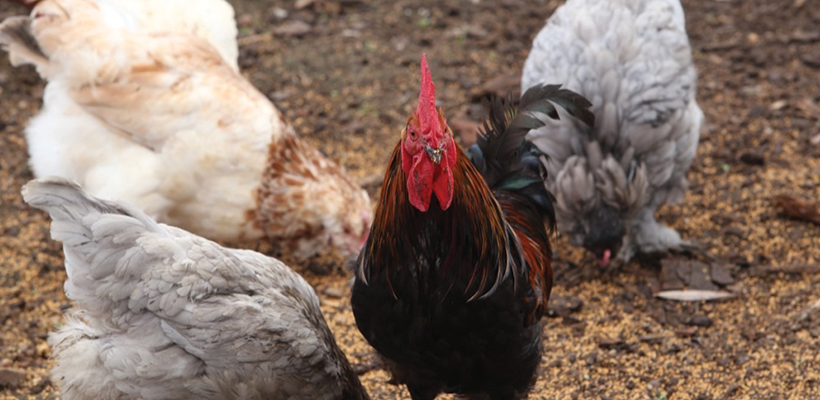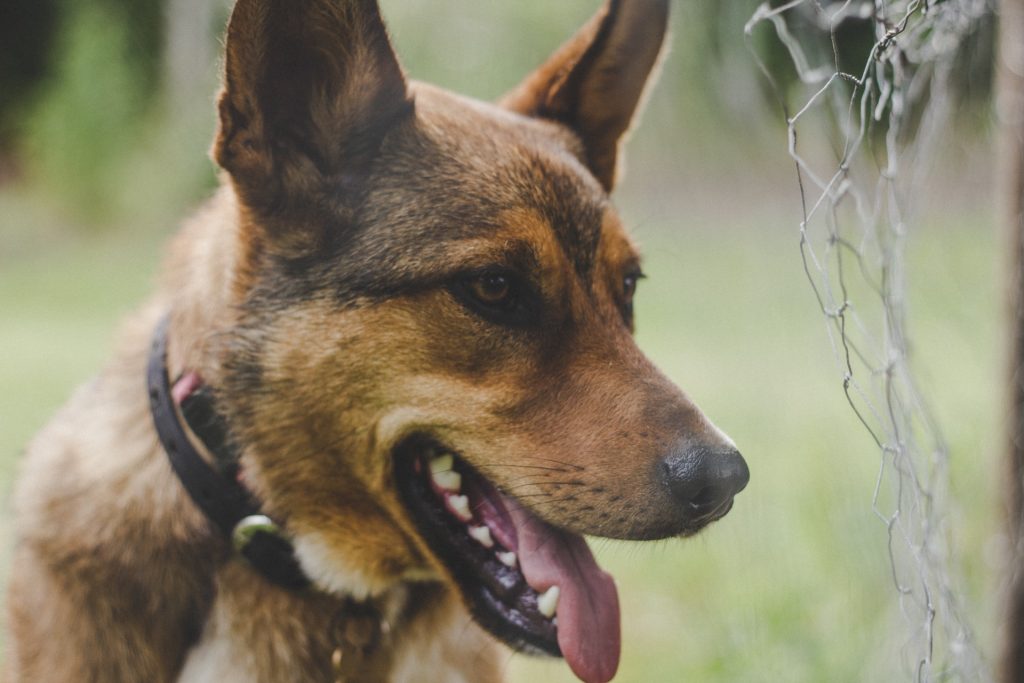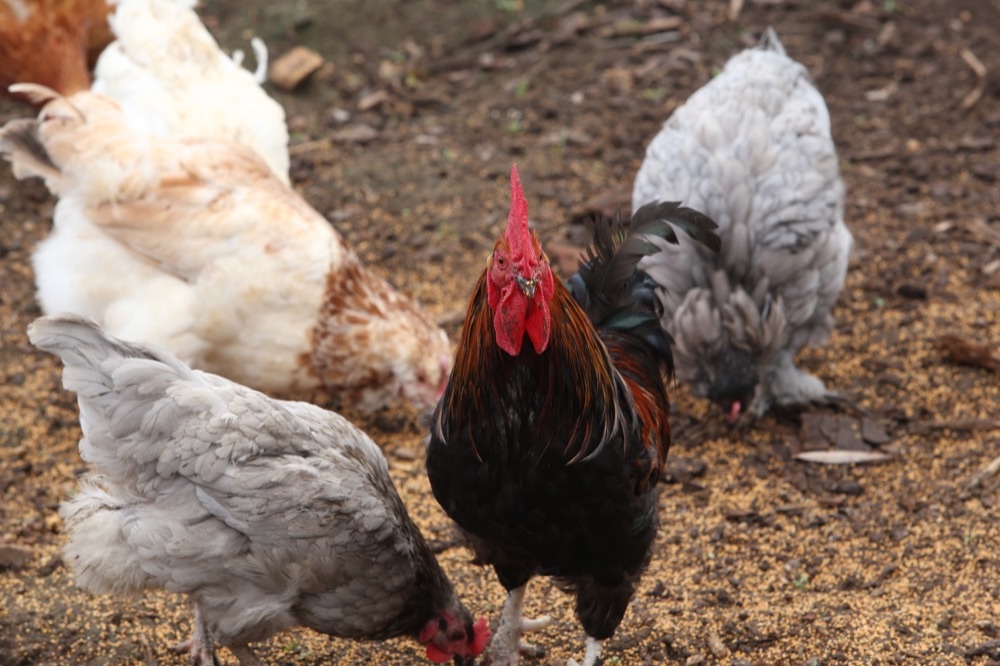
This article is contributed by guest writer, Chris Lesley (Founder of Chickens And More).
The Complete Guide to Introducing Chickens and Dogs
Anyone who has owned both dogs and chickens know that they have completely different personalities and care needs. However, these owners also know that, despite their differences, dogs and chickens can get along great! This guide will cover the key steps to introducing new chickens to the family dog, or a new dog to a pre-established flock of chickens.

Photo Credit: Chris Lesley
Consider space needs
Both chickens and dogs need plenty of room to roam; keep this in mind when determining where to place a coop or where the dog’s play area will be in the backyard. For the first few days, it is critical that the dog and the chickens have separate territories. This way they can become familiar with the new scents and sights without being overstimulated.
Next, determine where the introductions will take place. It is best to keep it on neutral ground so that none of the animals become territorial. For instance, do not have the interaction inside the chicken run. Plus, the animals will need somewhere they feel safe to retreat to if the first interaction is stressful or exhausting.
Make sure all pets are healthy
Lice, fleas, ticks, and worms are a few of the dangers that can spread between both dogs and chickens. Inspect all pets for any signs of parasites or illnesses before the introduction to be sure they will not make each other sick. Additionally, unhealthy animals often feel more stressed or vulnerable, so ensuring they are all healthy will also ensure a calmer meeting. If unsure how to check for health issues, schedule an appointment with a veterinarian.

Photo Credit: Tim Cooper via Unsplash
Keep them restrained
After the dogs and chickens have gotten familiar with seeing each other and smelling each other, they are ready to meet up for the first time. During this meeting, it is essential that proper boundaries are established for several reasons. Number one, some dogs may be overly playful or aggressive towards the chickens and could hurt them. Number two, some chickens establish pecking orders, and they may try to put the dog in his place. Different breeds of dogs and chickens are less prone to these behaviors, however owning a specific breed will not guarantee a peaceful relationship.
There are a couple ways to ensure a positive first interaction. First, consider keeping the dog and the chickens separated by a fence. This way they can interact without the risk of hurting each other. Another method is to keep the dog on a leash, while holding the chickens. When using this method, only introduce one to three chickens at a time so the dog doesn’t get overwhelmed. This is a great way to maintain control over the interaction, however certain breeds of chickens won’t react well to being held, so make sure the chickens are comfortable with this before starting the introductions. Additionally, make sure the leash is not too tight or short so that the dog does not feel restrained or vulnerable.

Photo Credit: Cameron Elder via Unsplash
Keep the numbers small
When introducing pets, one of the biggest problems that can occur is overstimulation. When the pets are introduced to each other, they are also being introduced to some drastic life changes. Having too many distractions, too many noises, or especially too many animals leads to overstimulation, which in turn leads to stress-induced outbursts because there are too many new things happening all at once. To avoid stress from overstimulation, the best thing to do is limit interactions to two or three animals during the first meeting, then gradually increase the number over the course of multiple meetings. Another option is to rotate which chickens are interacting with the dog; this is faster and prevents the chickens from being overstimulated, however the dog may get socially exhausted from this method.
Use commands and training methods
Unfortunately, chickens are not very trainable, but dogs are! Using the commands that the dog already knows can make the introduction go much smoother. Tell the dog to “sit” or stay,” and give little rewards for good behavior. If the dog is getting very aggressive, consider using a noise maker to alert him that the behavior is wrong. If the dog is anxious or timid, use affirmations and pet him gently.
Even though chickens cannot be trained, per se, their behavior can be swayed. Some chickens, like dogs, may respond positively to being petted or to receiving treats. Plus, staying calm during the interaction will help the animals to stay calm!

Photo Credit: Chris Lesley
Consider the age of the chickens
There is a big difference between baby chicks and adult hens. Adult hens are generally easier to care for and are much safer to introduce to dogs since adults are less fragile. If introducing a dog to chicks, wait until the chicks are at least 7-8 weeks old; this way, the chicks will be fully feathered and can be kept outside. Then, make the introductions gradual, starting with just one chick. Let the dog sit, while cupping the chick with both hands. This can be done repeatedly with multiple chicks until they start to become comfortable with one another.
Introducing chickens to a dog while they are still baby chicks can promote a stronger bond between the animals. Just be sure to never leave them unattended to ensure safety.
Chickens and dogs may be raised and cared for differently, but that does not mean they won’t get along. By doing research before introducing them and staying calm and collected during the process, chickens and dogs can become close friends.

Linda hunt
October 14, 2020 at 3:53 PMGreat information in this article.i’ll try these suggestions tonight.
Daniella
June 20, 2023 at 10:51 AMEverything is very open with a really clear clarification of the challenges.
It was definitely informative. Your site is extremely helpful.
Thanks for sharing!